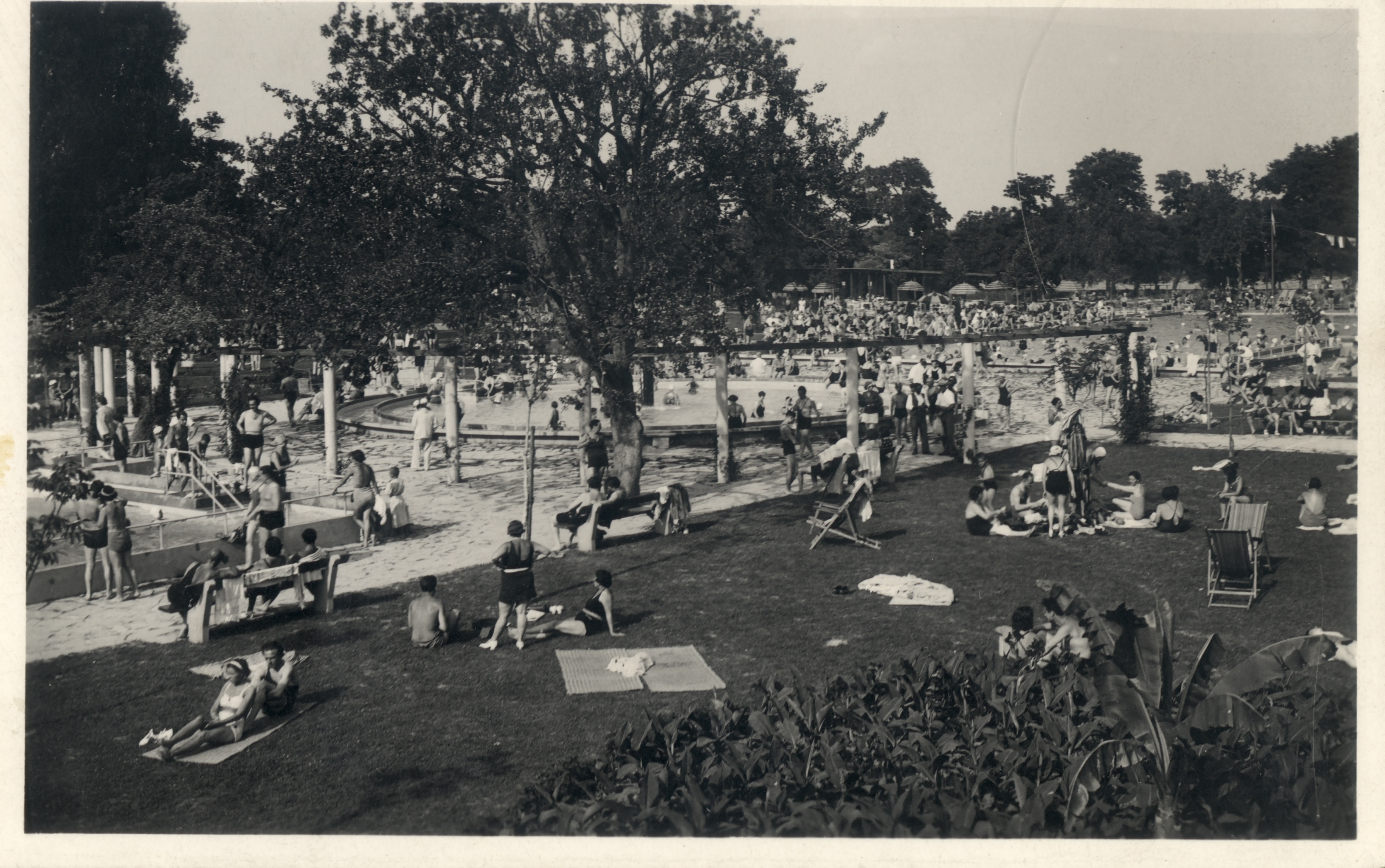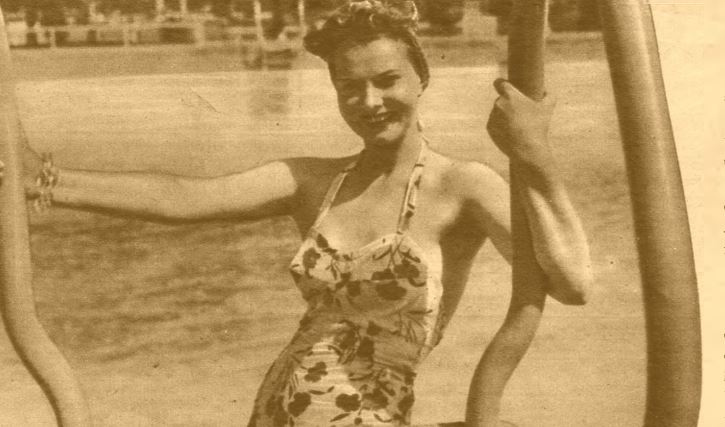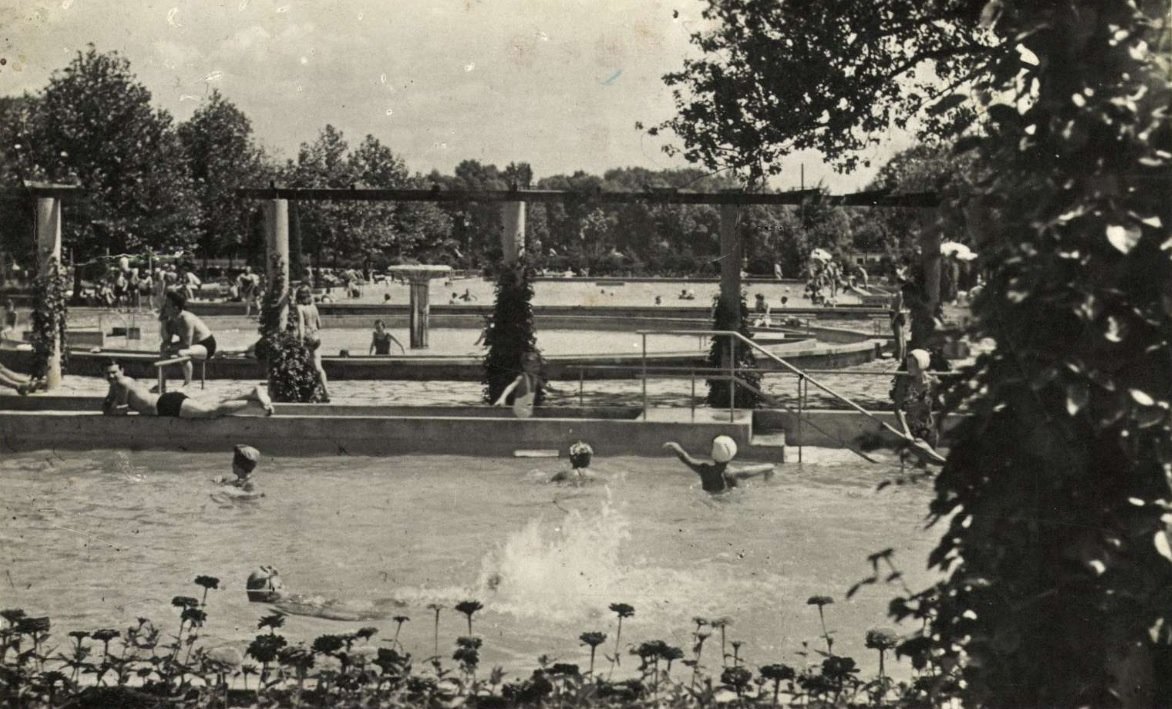Legal advisor dr. Sándor Ember, who bought a plot of land near Békásmegyer on the banks of the Danube a few years earlier, received important news by telephone on Whit Monday in 1934. Only his wife was at home, so she answered the call. Workers from Békásmegyer called with the great news that the drilling started on the site had led to results and medicinal water burst from under the 350-metre-deep clay layer, more than 500 metres deep.
It finally proved that Sándor Ember had made a good decision when, after accidentally learning about the intention to parcel the area during a rowing tour on the Danube, he bought the site, which hid not only valuable medicinal water but also unique archaeological finds.
The founder of Pünkösdfürdő Bath, Member of Parliament, dr. Sándor Ember on Lake Balaton in 1940 (Fortepan/Károly Ember, No.: 40798)
It was the golden age of baths and beaches in and around the capital: the Budapest Spa City Association was founded in 1922, and then in 1929, bathing life was regulated by law. Hungarian bathing culture was also respected internationally, as Baron Sándor Korányi was elected President of the International Balneological Society in 1929, and in the following decade, in 1937, the Gellért Hotel hosted the first congress of the international association.

A peaceful summer day on the beach on Pünkösdfürdő beach (Photo: www.punkosdfurdo.hu)
In addition to our old prestigious baths, interest in beaches also picked up in the period. Several smaller and larger beaches were established, where, according to contemporary recordings and reports, guests have flowed into, and the tabloids had also been happy to report on which beach a celebrity used to go to.
This “beach fever” may have motivated legal counsel Sándor Ember, a later Member of Parliament, to initiate drilling on the plot on the banks of the Danube in search of medicinal water.
Picture of the Pünkösdfürdő Bath under construction in the pages of the Hidrológiai Közlöny in 1935
The story is like a fairy tale because from the moment Sándor Ember accidentally learned about the intention to parcel the area during a rowing tour on the Danube and bought the land after a quick decision as if everything had turned into gold. At the twilight of his life, the former representative, who was forced to emigrate in 1945, stated in the September 1981 issue of the Canadian newspaper Chronicle:
“At that time (in the 1920s) as a member of the MAC (Magyar Atlétikai Club, 'Hungarian Athletics Club'), I often went paddling in the area. There was a beautiful lawn there, centuries-old trees under which it was pleasant to lie down. When one day I overheard that they wanted to parcel it out, offering five thousand pengő more for it, I bought the whole area. It was only after it turned out that it had medicinal water and was very rich in archaeological finds. Five layers were excavated, all the way to the New Stone Age. Crete-Mycenaean culture had infiltrated this far. The same beautiful pots, lots of human bones ...”
The villa of Sándor Ember was already standing in the area bought in the 1920s, and archaeologists discovered the above-mentioned finds near the building in the autumn of 1931. The excavations continued for a long time, and even in 1936, important artefacts were found.
Picture of the children's pool on the beach from the 1935 volume of the Hidrológiai Közlöny
Surely, artefacts important to historical science must have been uplifting for the landowner but let us not forget that a rowing tour led to the purchase of the land and the owner was a member of the Hungarian Athletics Club. Therefore, the opportunities in water and water sports perhaps were perhaps more important, to the ambitious owner, who therefore invited the geologist Ferenc Pávai-Vajna, a great figure of Hungarian thermal water research, to the site, who at first did not give much encouragement about medicinal water in the area.
“But I was sticking to my guns so that if we drill the blue clay barrier at a depth of 350 metres, we would have to get water. And that is what happened. It was just Whit Monday when the workers called my wife and reported that “we have the water” ... Well, that is why it became Pünkösdfürdő!”
The “father” of Pünkösdfürdő Bath, Sándor Ember, born in Felsőbánya in Szatmár County (today's Baia Sprie, Maramureș County in Romania) in 1889, was a versatile individual. He graduated in law, served on the battlefield for two years in World War I, from where he retired as a lieutenant general, opened a law firm in 1918, and then enrolled as a medical student after the Hungarian Soviet Republic. He soon worked as a legal adviser, but sport played an important role throughout his life, he also held sports leadership positions. From 1936, he became a Member of Parliament for the Pomáz constituency and then served as a flight-lieutenant during World War II. In 1938, he also played a significant role in the construction of Ferihegy Airport. After the war, he emigrated to Lugano, Switzerland.
After the successful drilling and the discovery of the medicinal water, the planning and the work began, and after just over a year, the Pünkösdfürdő Bath was ready. The area was not part of Budapest at the time, but transport was as good as it is today. When the beach opened, there was a regular bus line from the suburban railway station in Békásmegyer, which was 25 minutes away from Margit Bridge to Pünkösdfürdő Bath, a few hundred metres away.
„Dunacsillag” - Design of the Pünkösdfürdő Bath by Alfréd Hajós (Source: Hidrológiai Közlöny, 1935)
The designer of the beach was Alfréd Hajós, the first Olympic champion of Hungary, as well as an excellent architect, who made other plans for the beach. While the plans survived they were never realised. In more fortunate historical circumstances, the always aspiring Sándor Ember could have at least partially realised them.
The next day's issue of the Nemzeti Ujság published an interesting and detailed review titled "Get off! Pünkösdfürdő!" about the opening ceremony of the beach held at noon on 6 July 1935. The paper emphasized that the excellent water of the Pünkösdfürdő Bath, fed from the water of the Pünkösd Spring, rivals any of the thermal baths in Budapest.
The family of Sándor Ember captured the beach in colour. The picture is from 1940 (Photo: Fortepan/Károly Ember, No.: 40876)
The article mentions that a special train also ran on the suburban railway line for the event.
The guests were greeted at the entrance of the beach by Sándor Ember and his wife, the founders of the spa. How different this age was from today is also evident from the following: “Around the bath, the 831st St. Christopher's Scouts were stationed. At the altar of the camp, Richárd Weiszenberger, the parish priest of Békásmegyer, celebrated mass with the help of the parish priest Pál Zsámboky from Csillaghegy and Chaplain Alajos Raáb.”

Female nude. The work of sculptor György Gách and flight officer has been standing on the beach in Pünkösdfürdő Bath since 1943 (Photo: www.punkosdfurdo.hu)
There are some interesting details about the project:
“Sándor Ember described the history of the Pünkösd Spring and the work in which, with the involvement of Swiss capital around Whitsun last year - hence the name of the bath -, the drilling was so successful that from a depth of 556 metres a 25 degrees spring burst to the surface.”
An interesting observation is how Sándor Ember's personal contacts affected Pünkösdfürdő. It is known that, among many other positions, he was a legal adviser to the Consulate General of Switzerland and apparently secured Swiss capital for the business through this. Another tangible memory of his connections - the work of a female nude sculpture by György Gách - can still be found on the beach today. In addition to Gách's sculptural activities, he was a flight officer and Sándor Ember could knew him from military service.

Actress Zita Szeleczky on Pünkösdfürdő beach in 1942. Photo from the 5 August 1942 issue of the Mozi Ujság
The great figure of Hungarian sports life, the designer-architect Alfréd Hajós, also appeared at the opening and gave a short speech about the details of the construction. He mentioned that he designed the “new system” locker rooms for about 5,000 people.
Alfred Hajós in 1935 (Photo: Színházi Élet, Vol 1935, Issue 52)
After Alfred Hajós, Franz Kienast, Consul General of Switzerland spoke, as the creation of the bath, as quoted above, was supported by Swiss capital. He was followed by Secretary of State Antal Petneházy, who praised the importance of the bath in his speech.
"Cheerful life in the children's pool of Pünkösdfürdő Bath" (Photo: Színházi Élet, Vol 1935, Issue 30)
After the opening speeches, the stroke of the gong was heard, then a cannon rumbled. Finally, the raising of the national flag signalled the opening of the bath.
“Pünkösdfürdő, in view of last year’s high attendance, expanded this year. New rows of cabins were built, a new swimming pool was made, and the Danube-side of the restaurant was significantly enlarged" - caption under the photo in Színházi Élet, Vol 1937, Issue 34.
Thus began the history of the Pünkösdfürdő Bath. After the opening, the bath continued to develop in the 1930s, and soon a new pool and new rows of cabins were established. These were needed as the beach was very popular from the beginning. This has been the case ever since and we hope that the beach, which was been renovated in 2002-2003, will open shortly this year, and what started on that Whitsun 86 years ago will continue in 2021.
Cover photo: The Pünkösdfürdő Bath in the 1940s on a contemporary postcard





































Hozzászólások
Log in or register to comment!
Login Registration